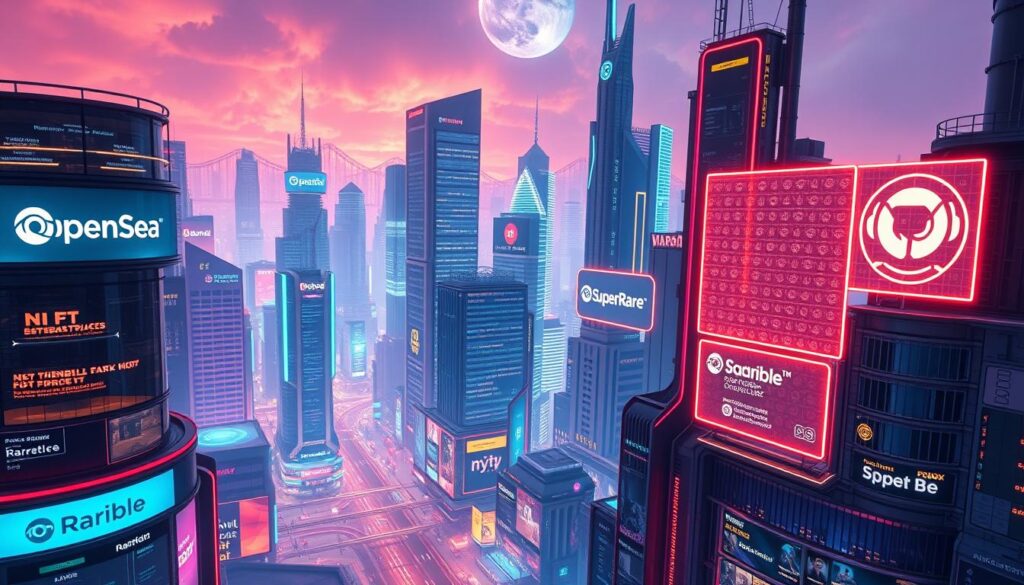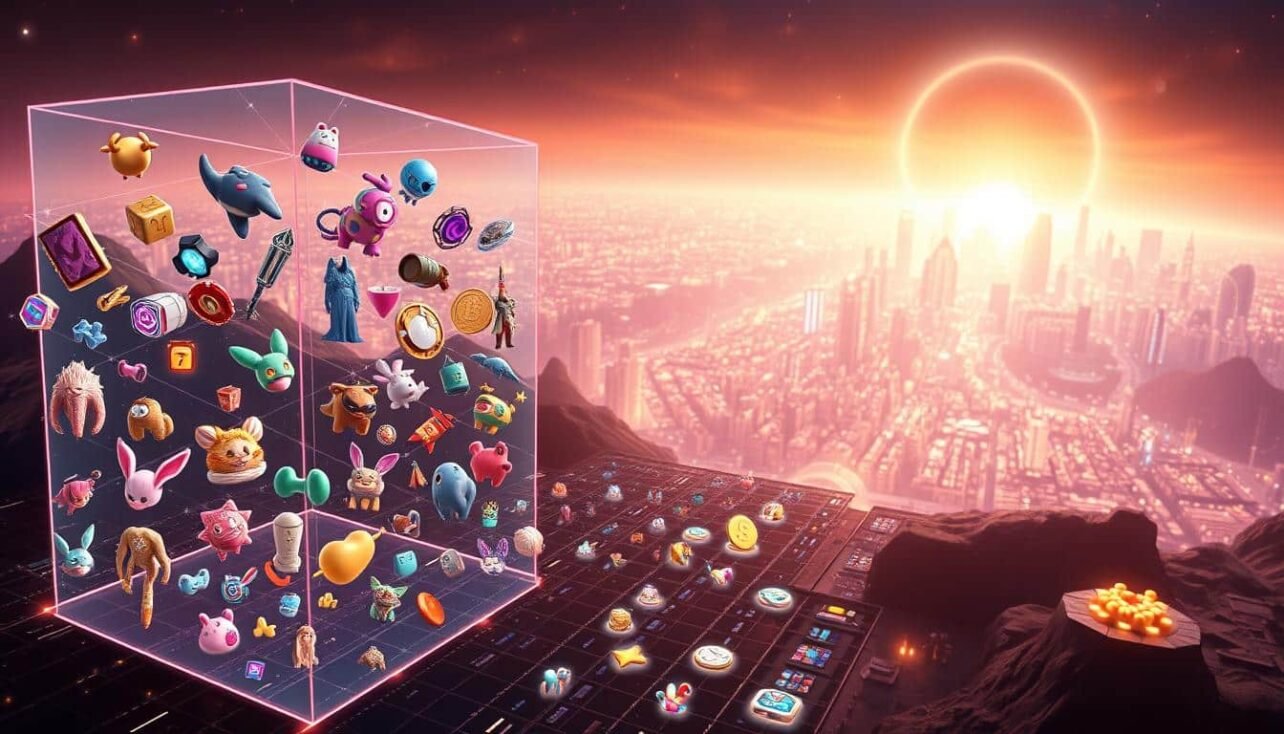The rise of blockchain technology has reshaped how we own and trade value online. At the forefront of this shift are one-of-a-kind blockchain-based items, which enable verifiable ownership of everything from digital art to virtual real estate. Unlike traditional cryptocurrencies, these assets are entirely unique—each carries distinct data that can’t be replicated or replaced.
To participate in this growing ecosystem, users need three core tools: a crypto wallet, funds to transact, and access to a specialized platform. These platforms act as hubs where creators and collectors connect, offering features like auctions, royalties, and secure ownership tracking. Popular examples include OpenSea and Rarible, though options vary widely in fees, audience, and supported formats.
This guide simplifies the process of choosing where to buy or sell. We’ll break down how different platforms cater to specific niches—like gaming items versus fine art—and what fees or technical requirements to expect. Whether you’re an artist exploring new revenue streams or an investor seeking rare collectibles, understanding these details ensures smarter decisions in a fast-moving space.
Key Takeaways
- Ownership of digital items is secured through blockchain records, ensuring authenticity.
- A crypto wallet and compatible currency are required to transact on most platforms.
- Each asset’s uniqueness drives its value, unlike interchangeable cryptocurrencies.
- Market growth spans industries like art, music, gaming, and virtual property.
- Platforms differ in fees, audience size, and supported file types—research matters.
Introduction to the World of NFT Marketplaces
Digital ownership has evolved beyond simple files and folders. Today’s online economy thrives on unique blockchain-tracked items that range from animated art to virtual concert tickets. These platforms act as creative hubs where artists, gamers, and collectors meet to exchange value in entirely new ways.
What makes these spaces special? They host an unmatched variety of assets. Imagine browsing for:
- Limited-edition music tracks from rising artists
- Rare video clips of historic sports moments
- Virtual land parcels in metaverse worlds
Every transaction relies on blockchain verification, ensuring each item’s history stays transparent. This system protects buyers from counterfeits while letting creators earn royalties automatically. Over 80% of platforms now support multiple chains, including Ethereum and Solana, giving users flexibility in how they trade.
| Platform | Specialty | Blockchain Support | Fees |
|---|---|---|---|
| OpenSea | General Collectibles | Ethereum, Polygon | 2.5% |
| Rarible | Digital Art | Flow, Tezos | 1-2.5% |
| Foundation | High-End Art | Ethereum | 15% |
| Solana-Based Hubs | Gaming Assets | Solana |
Mainstream adoption continues to grow. Major brands now release exclusive content through these channels, blending digital innovation with traditional collecting. Whether you’re a first-time buyer or seasoned trader, understanding platform specialties helps navigate this dynamic space effectively.
Understanding NFTs and Their Unique Digital Nature
In an era where digital content floods the internet, proving true ownership has become a revolutionary concept. Specialized blockchain-based certificates now authenticate originality, enabling creators and collectors to trade value with unprecedented clarity.

Definition and Core Concepts
These certificates function as digital fingerprints, storing irreplaceable data on decentralized ledgers. Unlike traditional files, each contains:
- Unique metadata verifying authenticity
- Smart contracts automating royalties
- Cross-platform compatibility via ERC-721 standards
For example, a musician can encode royalty payments directly into their work using blockchain technology, ensuring earnings from every resale.
Ownership, Scarcity, and Provenance
Ownership isn’t just claimed—it’s mathematically proven. Limited editions create artificial rarity, while blockchain records track every transaction back to the creator. This solves three key issues:
- Counterfeit prevention through immutable history
- Value retention via controlled supply
- Transparent attribution for original artists
Platforms use these principles to build trust. As highlighted in this analysis, provenance transforms digital files into collectible assets with verifiable stories.
Exploring Top NFT Marketplaces
Innovative hubs have emerged as central points for trading unique digital assets. These spaces blend creativity with blockchain technology, offering tailored experiences for different communities.

Platform Leaders and Their Strengths
Three platforms dominate the landscape. OpenSea leads with support for Ethereum, Polygon, and Solana, attracting 1.5 million active users quarterly. Its vast catalog includes everything from profile pictures to 3D virtual homes.
Magic Eden thrives on Solana’s speed and low fees. This makes it ideal for gaming items and time-sensitive drops. Over 60% of Solana-based transactions occur here.
Rarible stands out with decentralized governance. Holders of its RARI token vote on platform upgrades, creating a community-driven ecosystem.
| Platform | Blockchains | Fees | Key Feature |
|---|---|---|---|
| OpenSea | Ethereum, Polygon, Solana | 2.5% | Largest user base |
| Magic Eden | Solana | 2% | Fast transactions |
| Rarible | Ethereum, Solana, Flow | 2.5% | Token-based governance |
Growth Patterns and User Behavior
Adoption rates surged 300% last year across major platforms. Gaming assets now represent 34% of all trades, while music files grew by 120%.
New users prefer platforms with tutorials and low entry costs. Over 75% of first-time buyers start with sub-$50 purchases. This trend pushes platforms to simplify onboarding and offer gas-free minting options.
A Deep Dive into OpenSea: The Leading NFT Marketplace
OpenSea stands as the largest hub for trading unique digital assets, serving over 1.5 million active users monthly. Its success stems from balancing accessibility for newcomers with advanced tools for seasoned collectors. The platform’s design emphasizes simplicity while supporting complex trading strategies.

Platform Features and Transaction Fees
A 2.5% fee on sales keeps costs predictable for creators and buyers. This rate applies whether you’re selling a $50 avatar or a six-figure virtual land parcel. OpenSea supports:
- Customizable storefronts for artists
- Bulk listing tools for large collections
- Real-time royalty tracking
Over 16 integrated wallets—including MetaMask and Coinbase—streamline transactions. Users can track bids, manage inventory, and analyze trends through a unified dashboard.
Integration with Multiple Blockchains
Cross-chain compatibility lets traders operate across four major networks:
- Ethereum (ERC-721 standard)
- Polygon (low-fee option)
- Solana (high-speed trades)
- Arbitrum (scalable infrastructure)
This multi-network approach prevents congestion during peak activity. Artists minting new works can choose chains based on gas fees or environmental preferences, while collectors diversify holdings without platform-hopping.
Spotlight on Magic Eden and Solana-Based Platforms
Speed defines the next generation of digital asset trading. Magic Eden dominates Solana’s ecosystem, processing transactions in seconds at fractions of Ethereum’s costs. Over 60% of Solana-based trades happen here, driven by gas fees under $0.01 and instant settlement.
- Curated drops from top gaming and art projects
- No-code minting tools for creators
- Cross-chain swaps with Ethereum assets
Competitors like DigitalEyes Market focus on seamless SOL integration, letting users trade tokens and collectibles in one place. Solport takes a quality-first approach, vetting each submission to maintain premium standards. Both leverage Solana’s proof-of-history consensus for reliability.
Network effects fuel growth. Developers building on Solana receive grants through Magic Eden’s partnership program, while creators enjoy 95% lower fees than Ethereum alternatives. As Solana’s ecosystem expands, these platforms attract users prioritizing efficiency over legacy systems.
Adoption patterns reveal strategic shifts. Over 40% of new users choose Solana-based hubs for their first purchase, drawn by mobile-friendly interfaces and predictable pricing. This migration reshapes how artists monetize work and collectors diversify holdings across blockchain networks.
Rarible: Empowering Creators with Decentralized Governance
Community-driven platforms are redefining how digital assets are managed and traded. Rarible stands at the forefront of this movement, offering tools that put creators and users in control of platform decisions. Through its RARI token, holders influence upgrades and policies—a stark contrast to traditional top-down management.

Distinctive Tools for Digital Creators
Rarible’s lazy minting removes upfront costs for artists. Instead of paying blockchain fees when listing work, buyers cover these during purchase. This feature opens doors for emerging creators testing the waters.
The platform supports three major networks:
- Ethereum for established collectors
- Solana for fast, low-cost trades
- Polygon for eco-conscious minting
| Feature | Benefit | Blockchain Support |
|---|---|---|
| Lazy Minting | No upfront creator fees | All supported chains |
| RARI Governance | Community voting rights | Ethereum-based |
| Multi-Chain Access | Flexible network choices | 3 options |
| Live Training | Step-by-step guidance | Platform-wide |
Weekly live sessions help users master minting and trading. For a deeper exploration of Rarible’s mechanics, check out this guide on getting to know Rarible.
With 2.5% fees split between parties and real-time royalty tracking, the platform balances accessibility with sustainable operations. Over 45% of new artists choose Rarible for its educational resources and governance opportunities.
Comparing Key Features Across NFT Marketplaces
Digital collectible platforms have developed distinct identities through specialized tools and audience targeting. OpenSea leads with versatility, supporting 16+ integrations for diverse blockchain assets. Rarible prioritizes creator empowerment through governance tokens and royalty automation.
Niche platforms carve unique spaces. Nifty Gateway attracts luxury collectors with limited releases, while Magic Eden dominates gaming assets through Solana’s speed. Fee structures vary widely—from 1% on lean platforms to 15% on curated spaces.
Technical capabilities shape user experiences. Broad platforms offer multi-chain support and bulk listing tools. Specialized hubs focus on tight integrations—like Solana-based wallets or live minting tutorials. Over 75% of new users choose platforms with intuitive mobile interfaces.
Choosing the right service depends on priorities. High-volume traders need advanced analytics, while artists value lazy minting and royalty tracking. As blockchain ecosystems evolve, these key features determine which platforms thrive in serving specific communities.


No comments yet